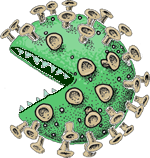Cyber-Security:
 Viruses
Viruses 
Although many pieces of malware get called viruses, they are nothing of the sort.
 A virus is a piece of software that has been created in order to insert copies of itself into applications and data and onto crucial parts of a computer's data storage systems (e.g. hard disks, memory sticks, etc). They are self-replicating programs and date back as far as the early 1970s, but they only became well known with the advent of microcomputers and later, the internet.
A virus is a piece of software that has been created in order to insert copies of itself into applications and data and onto crucial parts of a computer's data storage systems (e.g. hard disks, memory sticks, etc). They are self-replicating programs and date back as far as the early 1970s, but they only became well known with the advent of microcomputers and later, the internet.
 A computer virus modifies other legitimate host files (or pointers to them) in such a way that when a victim host's file is executed, the virus is also executed. Viruses attach themselves to specific applications on a computer and are activated as soon as the program is run after 'infection'. At that point, the virus may make a copy of itself on the hard disk and continue to run, or it may only run each time the application is used.
A computer virus modifies other legitimate host files (or pointers to them) in such a way that when a victim host's file is executed, the virus is also executed. Viruses attach themselves to specific applications on a computer and are activated as soon as the program is run after 'infection'. At that point, the virus may make a copy of itself on the hard disk and continue to run, or it may only run each time the application is used.
 Pure computer viruses are uncommon today, making up less than 10% of all malware. Which is a good thing as virus infection in a system is very serious.
Pure computer viruses are uncommon today, making up less than 10% of all malware. Which is a good thing as virus infection in a system is very serious.
 Viruses are the only type of malware that "infects" other files, making them particularly hard to clean up because the malware must be removed from the legitimate program. This has always been a difficult procedure, and today it's almost impossible. Even the best antivirus programs on the market struggle to do it correctly and in most cases will simply quarantine or delete the infected file instead.
Viruses are the only type of malware that "infects" other files, making them particularly hard to clean up because the malware must be removed from the legitimate program. This has always been a difficult procedure, and today it's almost impossible. Even the best antivirus programs on the market struggle to do it correctly and in most cases will simply quarantine or delete the infected file instead.
 That means the infected program is also quarantined or deleted - a loss to the user.
That means the infected program is also quarantined or deleted - a loss to the user.
 The spreading of a virus
The spreading of a virus
Early viruses spread quickly because in those days programs were stored on floppy disks. Those disks were often shared around an office - people copying them for their own use. Therefore transmission was rampant. Also in those days pirated software was passed around the playground via a copiable floppy disc.
Nowadays, viruses have to rely on devices such as flash memory cards or are transmitted through internet connections.
 Outcome of Virus Infection
Outcome of Virus Infection
Although some viruses are not intended to cause harm (just annoy), the majority of these programs are designed to harm users, by:
 corrupting their data
corrupting their data
 attacking the operating system of the device/machine
attacking the operating system of the device/machine
 providing an exploitable 'back door' to the computer
providing an exploitable 'back door' to the computer
Even where no harm is intended, viruses consume memory, disk space and processing power.

